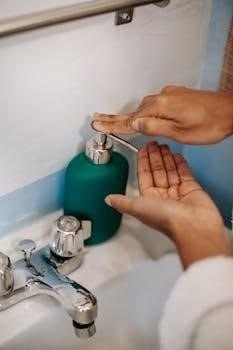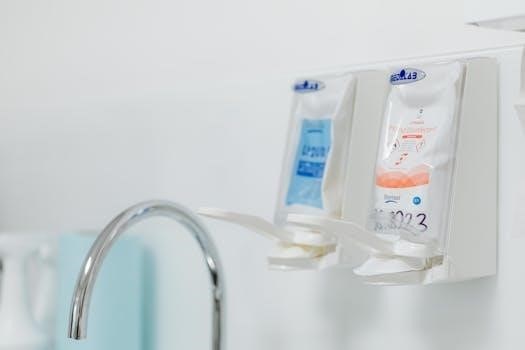What is a Manual Soap Dispenser?
A manual soap dispenser is a device that dispenses soap through a hand-operated mechanism, typically a pump or lever․ These dispensers are commonly found in bathrooms and kitchens, offering a simple method for accessing soap․
Definition and Purpose
Manual soap dispensers are devices designed to release a controlled amount of soap when a user physically interacts with a pump or lever mechanism․ Their primary purpose is to provide a convenient and accessible means for handwashing, promoting hygiene in both private and public settings․ Unlike automatic dispensers, manual versions rely on direct user action to dispense soap, offering a straightforward and reliable method for cleaning․

Types of Manual Soap Dispensers
Manual soap dispensers can be categorized primarily by the type of soap they dispense⁚ liquid soap dispensers and foam soap dispensers․ Each type has unique mechanics for delivering the soap․
Liquid Soap Dispensers
Liquid soap dispensers utilize a pump mechanism to draw liquid soap from a reservoir․ When the pump is pressed, a piston moves, creating suction and drawing soap up through a tube; These dispensers are widely used due to their simplicity and ability to handle a variety of liquid soaps, including hand soap, dish soap, and shower gels․ They are also available in different sizes and designs and can be wall-mounted․
Foam Soap Dispensers
Manual foam soap dispensers create a foamy lather by mixing liquid soap with air as it’s dispensed․ These dispensers commonly feature a push-button or lever system that forces the mixture out․ Many utilize a bladder system where the soap is contained, often diluting the soap with water before dispensing․ The result is a lighter, airy foam, which is often preferred for its gentle feel and efficient soap usage compared to liquid soap․

How Manual Soap Dispensers Work
Manual soap dispensers operate via a simple pump or lever mechanism․ When activated, this mechanism draws soap from the reservoir and dispenses a controlled amount, typically using air pressure․
The Pumping Mechanism
The pumping mechanism in a manual soap dispenser typically involves a piston, a spring, and a nozzle; When the user presses down on the pump, the piston moves, compressing the spring․ This action forces air out of the chamber creating a vacuum․ The vacuum draws the soap up a tube and then dispenses it through the nozzle․ This process is simple yet effective, ensuring a controlled release of soap․
Air Pressure and Gravity
The functionality of manual soap dispensers relies significantly on the interplay between air pressure and gravity․ When the pump is activated, a vacuum is created within the dispenser, drawing the soap upwards․ Simultaneously, gravity aids in the downward flow of the soap through the dispensing tube․ This combined action ensures that the soap is efficiently dispensed each time the pump is pressed, providing a reliable way to access soap․
Materials and Construction
Manual soap dispensers are commonly constructed from materials like stainless steel and plastic․ These materials are chosen for their durability, resistance to corrosion, and ease of cleaning, ensuring longevity․
Stainless Steel
Stainless steel is a popular choice for manual soap dispensers due to its sleek, modern appearance and exceptional durability․ This material is highly resistant to rust and corrosion, making it ideal for humid environments like bathrooms․ Stainless steel dispensers are also easy to clean and maintain, contributing to better hygiene․ They provide a robust and long-lasting option, suitable for both home and commercial use, withstanding frequent use․
Plastic
Plastic is another common material used in the construction of manual soap dispensers, offering a lightweight and cost-effective alternative to stainless steel․ Plastic dispensers are available in a wide range of colors and designs, making them versatile for different decors․ While not as durable as stainless steel, they are still suitable for many applications, particularly in residential settings․ Plastic dispensers are also easy to mold, allowing for various shapes and sizes․
Installation and Mounting
Manual soap dispensers can be installed in various ways, often wall-mounted to save counter space․ These dispensers are designed for easy setup, ensuring they are securely attached for reliable use․
Wall-Mounted Options
Wall-mounted manual soap dispensers are a popular choice for both residential and commercial settings due to their space-saving design․ These dispensers are directly attached to the wall, keeping countertops free from clutter․ They are available in various materials and styles, providing options to match any decor and ensuring secure and stable placement․ Installation is typically straightforward, with mounting hardware included, making them a convenient and practical option․

Refilling and Maintenance
Refilling manual soap dispensers involves replenishing the soap reservoir when it’s low․ Regular cleaning is crucial to maintain hygiene and prevent clogs, ensuring the dispenser functions properly․
Refilling Process
The refilling process for a manual soap dispenser is generally straightforward․ Typically, it involves opening the dispenser, often by removing a lid or top section, and then carefully pouring liquid soap into the reservoir․ It is essential to avoid overfilling to prevent spills and ensure the proper functioning of the pump mechanism․ After refilling, the dispenser should be securely closed before use, and any spills wiped immediately to maintain cleanliness․
Cleaning and Hygiene
Maintaining the cleanliness and hygiene of manual soap dispensers is crucial for preventing bacterial growth․ Regular cleaning involves disassembling the dispenser, washing all parts with warm, soapy water, and rinsing thoroughly․ The pump mechanism should be cleaned to prevent clogs․ It is important to dry all components completely before reassembling to avoid any moisture buildup․ This regular maintenance ensures the dispenser remains hygienic for frequent use, especially in high-traffic areas․
Advantages of Manual Soap Dispensers
Manual soap dispensers offer simplicity and reliability, making them easy to use and maintain․ Their cost-effectiveness is another advantage, as they typically have lower upfront and maintenance costs․
Simplicity and Reliability
Manual soap dispensers are known for their straightforward design and operation․ They typically involve a simple pump or lever mechanism, which is easy for users to understand and operate․ This simplicity contributes to their reliability, as there are fewer complex components that could potentially malfunction․ With no reliance on electronic parts or sensors, manual dispensers offer consistent performance, providing soap when needed without the risk of battery failures or sensor errors․
Cost-Effectiveness
Manual soap dispensers are generally more cost-effective compared to their automatic counterparts․ Their simple design translates to lower manufacturing costs, making them more affordable to purchase․ Furthermore, since they do not require electricity or batteries, there are no ongoing operational expenses․ This makes them an economical choice for both home and commercial settings, particularly in environments where budgetary concerns are a key factor․ The absence of complex parts also reduces repair and replacement costs․
Disadvantages of Manual Soap Dispensers
Manual soap dispensers, while simple, present some drawbacks․ A primary concern is the potential for cross-contamination due to the need to physically touch the dispenser to use it․
Potential for Cross-Contamination
Unlike automatic dispensers, manual soap dispensers require direct contact, which can lead to the spread of germs․ Each user touches the pump or lever, potentially transferring bacteria and viruses․ This makes them less hygienic, especially in high-traffic areas such as public restrooms, where many people may use the same dispenser․ Regular cleaning and sanitization of the dispenser are critical to mitigate this risk, but the potential for contamination always remains a concern․
Applications of Manual Soap Dispensers
Manual soap dispensers are widely used in various settings․ They are common in homes, offices, schools, and other public places․ Their simplicity and reliability make them suitable for diverse environments․
Home Use
Manual soap dispensers are a practical addition to any home․ They are commonly used in bathrooms and kitchens for everyday handwashing․ Their simple design makes them easy to use for all family members, including children․ They offer a convenient way to keep soap readily available, promoting good hygiene habits․ These dispensers can accommodate various types of liquid soaps and can add a decorative touch to the home․
Commercial Settings
Manual soap dispensers are frequently utilized in various commercial environments, including offices, restaurants, hotels, and schools․ These settings often require a durable and reliable solution for hand hygiene․ Manual dispensers offer a cost-effective way to provide soap to a large number of users․ Their simplicity and ease of maintenance make them suitable for high-traffic areas․ They can also be found in public restrooms, providing an accessible option for handwashing․

Comparison with Automatic Dispensers
Manual and automatic soap dispensers differ significantly․ Manual dispensers require physical contact, while automatic versions use sensors․ This difference impacts hygiene, convenience, and the overall user experience in various settings․
Hygiene Considerations
Manual soap dispensers, while widely used, can pose hygiene concerns due to the need for physical contact․ Touching the pump or lever can potentially transfer germs and bacteria between users, leading to cross-contamination․ This is a key difference from automatic dispensers, which minimize contact․ Regular cleaning of manual dispensers is crucial to mitigate these risks, especially in high-traffic areas, making them less hygienic than touchless options․ The mechanism itself can also harbor bacteria if not properly maintained․
Convenience Factors
Manual soap dispensers offer a straightforward and reliable way to dispense soap, requiring no electricity or batteries․ This simplicity makes them easy to use and maintain, as they do not rely on complex electronics․ Their availability in various sizes and mounting options provides flexibility for different spaces․ However, manual operation can be less convenient than automatic dispensers, requiring physical effort and potentially leading to inconsistent soap dispensing amounts, unlike controlled portions from automatic models․




